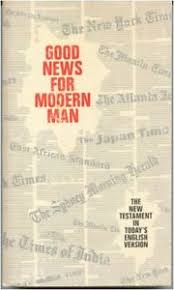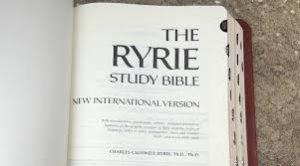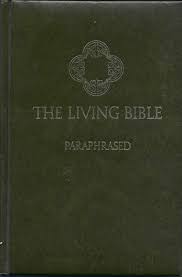by Shawn Crawford
 For a Baptist, the Bible exists like gravity. Not believing in gravity will not change the outcome if you step off a building; not believing the Bible will not change the consequences if you ignore its precepts and commands. Both are laws of nature, fixed and unchanging.
For a Baptist, the Bible exists like gravity. Not believing in gravity will not change the outcome if you step off a building; not believing the Bible will not change the consequences if you ignore its precepts and commands. Both are laws of nature, fixed and unchanging.
To really understand what it means to be Baptist, you must understand the unique place the Bible holds in every facet of life. The central reality of existence is not God but rather the words he left behind to guide our decisions, our relationships, and our behavior. Baptists create a world that revolves around The Book to a degree that can easily be termed idolatry. In a religion that shuns all iconography, the Bible becomes the one object that can be revered. But not because it symbolizes the presence of God’s word among us: it is God’s Word, infallible and unchangeable. The Southern Baptist statement of beliefs, The Baptist Faith and Message, begins with the Bible, not God. It states in part, “[The Bible] has God for its author, salvation for its end, and truth, without any mixture of error, for its matter.”
The close reading of scripture allowed you to extract the meaning God intended. That meaning could be discovered, not interpreted, and it could be agreed upon and then applied to how you lived your daily life: “Thy word is a lamp unto my feet and light unto my path” (Psalm 119.105). The Book of Psalms is in the middle of the Bible, and can best be translated “praises” or “songs” from the Hebrew. Psalm 119 is the longest chapter of the Bible, clocking in at 176 verses. Writers of Psalms often used an acrostic method employing the letters of the Hebrew alphabet. Psalm 119 is a tour de force, with each of eight verses in a stanza opening with the same letter, moving through all twenty-two letters of the alphabet.
As you might have guessed, I spent a lot of time with the Bible.
Or rather Bibles. At my zenith as a teenager in the 80s, I probably owned around a dozen, all serving a unique purpose. I had two go-to Bibles: the Sunday church Bible and a study Bible. Since you had to put on a decent shirt and pair of pants for Sunday, you wanted your Bible to look respectable as well. Mine had a leather cover with my name engraved on it, gold, gilt-edged pages, and the words of Jesus in red ink. A Bible known as a Thinline was all the rage. At less than an inch thick, the Thinline had paper as light and delicate as an angel’s wings. You had to be careful not to crease the pages, and you couldn’t even highlight your favorite verses because it would bleed through the Gospel of John all the way to the Acts of the Apostles.
 The study Bible was where you went to work deciphering all the messages God wanted to relay to you. I had the immensely popular Ryrie Study Bible, named for Charles Caldwell Ryrie, a professor at Dallas Theological Seminary. A study Bible generally contained introductions to the books of the Bible, cross-references to other scripture, and commentary on the verses, ranging from historical information to Don’t Get the Wrong Idea when the passage seemed confusing. When the rich young man comes to ask Jesus how to obtain eternal life, Jesus responds, “If you want to enter life, obey the commandments” (Matthew 19.17). The NIV Study Bible (you didn’t think I had just one study Bible did you?) tells us, “The requirement to ‘obey the commandments’ is not to establish one’s merit before God but is to be an expression of true faith. The Bible always teaches that salvation is a gift of God’s grace received through faith (see Eph. 2:8).” To recap: The Bible always teaches salvation through grace except when it doesn’t, but that’s not what Jesus meant even though Jesus always spoke the truth; you just heard him wrong. That was a close one. Thank you NIV Study Bible.
The study Bible was where you went to work deciphering all the messages God wanted to relay to you. I had the immensely popular Ryrie Study Bible, named for Charles Caldwell Ryrie, a professor at Dallas Theological Seminary. A study Bible generally contained introductions to the books of the Bible, cross-references to other scripture, and commentary on the verses, ranging from historical information to Don’t Get the Wrong Idea when the passage seemed confusing. When the rich young man comes to ask Jesus how to obtain eternal life, Jesus responds, “If you want to enter life, obey the commandments” (Matthew 19.17). The NIV Study Bible (you didn’t think I had just one study Bible did you?) tells us, “The requirement to ‘obey the commandments’ is not to establish one’s merit before God but is to be an expression of true faith. The Bible always teaches that salvation is a gift of God’s grace received through faith (see Eph. 2:8).” To recap: The Bible always teaches salvation through grace except when it doesn’t, but that’s not what Jesus meant even though Jesus always spoke the truth; you just heard him wrong. That was a close one. Thank you NIV Study Bible.
You couldn’t use just any old study Bible. A scholar had to arrive at the conclusions Baptists had decided the Bible contained. Even if they couldn’t formulate it, I think most Baptists of my youth believed there existed somewhere in history an Ur Bible, without blemish or error, that despite the intervening years and variant texts and insidious Catholics, had reconstituted itself in the Bible they now read.
In addition to study Bibles, “themed” Bibles were coming into vogue. I had a Youth Bible with commentary for teens written by forty-something Evangelical men trying to sound hip. Mainly it told you God was awesome and to obey your parents and not have sex. Just like the actual Bible, but with way more exclamation points and antedated slang. Soon there would be Bibles for moms and athletes and brands, like the Chicken Soup for the Soul Bible.
Then there was the tricky and contentious question of translations. I grew up just as the King James Bible was finishing its remarkable run of nearly 400 years as the unquestioned Authorized Version of the Bible in English, both in name and reality. Commissioned by King James VI of England, a group of forty-seven scholars began working in 1604 and finished the translation in 1611. Using the best Greek, Hebrew, and Aramaic texts available, the scholars worked to produce the most accurate translation possible while also affirming the doctrine of the Church of England. Re-edited by Benjamin Blayney in 1769, this would become the King James Version (KJV) most Americans knew and owned.
What allowed the KJV to endure was its gorgeous language and style. Later translations would prove more faithful to the original texts, but none would ever be more beautiful. The KJV was how God and Jesus sounded when they spoke in English. Period. The cadences and structure and allusions of the KJV would echo in literature and daily correspondence for centuries.
But the KJV proved tough sledding until you got the hang of it. The “thees” and “thous” and “verilys” are what people remember, but the real challenge resided in the syntax. Layers of subordinate clauses result in the subject searching longingly for its verb. Not unlike the father awaiting the return of the prodigal son. Even a simple verse like “For where your treasure is, there will your heart be also” (Matthew 6.21), requires some work, but the reward of the balance and rhythm make it worth the effort. Like poetry, the KJV shines brightest when read aloud.

But lo, the winds of change were blowing. The counter-culture of the sixties made its way to churches with an emphasis on modernizing the Gospel message, and nothing exemplified that need like the KJV. After centuries of unquestioned authority, the KJV would have competition from an onslaught of new translations and paraphrases. The first wildly popular of these was Good News for Modern Man, a translation of the New Testament produced by the American Bible Society. Published like a paperback novel, Good News had a grey cover with tiny newsprint and the mastheads of newspapers from around the world splashed jauntily across it. Inside, simple line drawings by the Swiss artist Annie Vallotton illustrated key passages. The entire production feels like your square uncle showing up for the family reunion in 1969 wearing a Nehru jacket. But after years of reading seventeenth-century English and looking at William Holman Hunt’s The Light of the World, reading Good News suddenly made Jesus seem kind of happenin’.
Good News employed a theory of translation called Dynamic or Functional Equivalence, developed by the linguist Eugene Nida. This expounded an idea of translation as “thought for thought” rather than “word for word,” phraseology still often employed by the Catholic church. As a Structuralist, someone that views language as a system of units that connects in different ways, Nida believed each system to be unique and therefore a “literal” translation would always remain illusionary.
But Nida and the American Bible Society still went back to the best original texts they could find to translate. In 1971, Kenneth N. Taylor, a veteran of several Christian publishing firms, and the founder of his own, Tyndale House, released The Living Bible. Using the American Standard Version translation of 1901, Taylor employed the Dynamic Equivalence approach to paraphrase the ASV into contemporary English. The Living Bible would become the best-selling book of 1972 and 1973. My copy, with its padded, green cover, had the gold lettering nearly rubbed off. The easy style made it ideal for trying to read the Bible straight through, although Leviticus, which really should be retitled God’s Guide to Slaughtering and Sacrificing, still destroyed my resolve every time.
 The Living Bible could get some of the faithful pretty riled up. My grandmother despised it. Exhibit A was I Samuel 20.30. King Saul flies into a rage, convinced his son Jonathan and David are conspiring against him. “You son of a bitch!” Saul shouts right there in the holy scripture, although in Taylor’s defense that’s a pretty fine translation of “you son of a perverse, rebellious woman” as rendered in both the ASV and KJV. Grandma would have none of it. “Just look at that!” she’d complain. “Look at what?” I’d slyly reply. Just reading the words thrilled me, but the thought of her saying them delighted me in a way that just confirmed my need for much more Bible study. Newer editions of The Living Bible have changed the verse to “You fool!” (yawn) and consigned the offending words to the footnotes.
The Living Bible could get some of the faithful pretty riled up. My grandmother despised it. Exhibit A was I Samuel 20.30. King Saul flies into a rage, convinced his son Jonathan and David are conspiring against him. “You son of a bitch!” Saul shouts right there in the holy scripture, although in Taylor’s defense that’s a pretty fine translation of “you son of a perverse, rebellious woman” as rendered in both the ASV and KJV. Grandma would have none of it. “Just look at that!” she’d complain. “Look at what?” I’d slyly reply. Just reading the words thrilled me, but the thought of her saying them delighted me in a way that just confirmed my need for much more Bible study. Newer editions of The Living Bible have changed the verse to “You fool!” (yawn) and consigned the offending words to the footnotes.
In the KJV Adam “knew” Eve, but in The Living Bible they have sexual intercourse, which was more than many Baptists wanted to “know” about people in the Bible. This uneasiness gets to the heart of the complexities of translation and religion itself. Part of the comfort of the KJV for me resided in the fact the strangeness of the language created a distance between me and the characters in the Bible. I wanted Jesus to be like me, but not too much like me. That distance helped to preserve the mystery of my faith, but it also subtly argued that no matter how hard I tried, I couldn’t really be expected to achieve the perfection the Bible demanded. Allowances had to be made, not just for my sinful nature, but for the fact the people in the Bible were another degree of humanity entirely. Adam and Eve didn’t have sex; they just “knew” it was time for a family and the kids showed up. This was the distance my grandmother craved: a world where people never cursed, and children appeared ex nihilo, and the beautiful language you read helped to minimize the blood and the gore and the harsh realities that ran rampant through the Bible.
In 1978 the International Bible Society released a new translation in English called the New International Version. Working for over a decade, a group of Protestant scholars consulted the most reliable texts available and combined a literal approach with Dynamic Equivalence to produce a translation that quickly became the standard in Evangelical churches. Except for the diehards, yea verily I say unto thee, the KJV hath died.
Regardless of the translation, I needed to study my Bible systematically through daily devotions. Entire conferences existed to help you in this endeavor; devotional journals allowed you to track your progress and record your insights; books guided you through important topics in the Bible like discipleship and prayer. All of this culminated in discerning the Application. What was God trying to say to me through the verses I read?
The Application made daily devotions thrilling. What might happen? Where could I end up if I heeded the call I found? Sharing the Application produced the second-most repeated phrase of the Baptist, “I just feel the Lord is telling me . . . .” The first being commencing every public prayer with, “Father, we just wanna . . . “ When I felt reluctant about what the Lord was relaying, I generally figured I was on the right track. This also sped up the guilt process.
What you found in the Bible got into questions of God’s will. We generally adhered to the idea of General and Specific will when it came to our lives. General will outlined what God expected of everyone and revealed itself readily: The Ten Commandments, Salvation, the Golden Rule. But God had also crafted a special plan just for you, and depending on how specific you thought Specific will got, this could include the person you should marry, your job, where to live, and every other detail of your life. Specific will tied me up into knots.
Just how chatty should God get in your daily devotions? Was he going to reveal lunch plans or paint in broader strokes? And what if I was following God’s will and the person chosen to marry me wasn’t? Did God have a plan B? Was I out of luck? Did one wrong turn lead to an eternity of regret or could you merge back onto the path? This wasn’t a game; I honestly believed I had to crack the code to live a contented life.
Finally, late in high school, someone told me if I just lived up to God’s General will, all the choices I made would be good choices. That was pretty much it. But we wanted complications and enigmas and knowledge others didn’t possess. Harold Bloom had every right to call religion in America Gnosticism. We swore obedience to the Book and in return received enlightenment not available to everyone else.
The Bible presented the opportunity to consider infinite scenarios, to always ask What If instead of What Is. I interpreted and imagined and fretted over what God wanted me to do at the expense of ever doing anything. The Baptist imagination remained buried in the words of the Book. Our entire culture dedicated itself to its secrets and meanings. The Bible supposedly guided the actions of your life, but I had time for little else but the parsing of what exactly those actions should be.
I believed in the Bible because otherwise the world threatened to run amok. All choices became binaries: either God or chaos; either obedience or a libertine life; the Bible’s formulation of morality or a meaningless world where I immediately felt like shanking someone that looked at me crosswise. The Bible as examined through the lens of the Baptist microscope only fostered further faith in the Bible; it never increased my faith in humanity or the course of events outside of the carefully cultured slide of scripture under my gaze. I never brought the rest of the world into focus.
